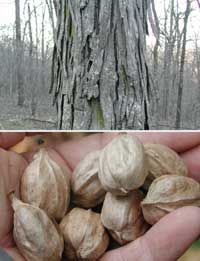Resource Library
Plant of the Week: Shagbark Hickory
The University of Arkansas System Division of Agriculture does not promote, support or recommend plants featured in "Plant of the Week." Please consult your local Extension office for plants suitable for your region.
Plant of the Week
Shagbark Hickory
Latin: Carya ovata

Most of upland Arkansas is an oak-hickory forest mix, yet few of us give hickories a second thought. It hasn’t always been like that.
During the age of wood when this country was young, hickories were one of our most important timber resources. But since the age of plastics, they have been sidelined. Nine species are described in the state, but of these the easiest to distinguish is shagbark hickory, Carya ovata.
Shagbark hickory is one of the largest hickories, growing to over 120 feet tall in a good site. Its main distinguishing characteristic is the smoky-gray peeling plates of bark that hang loosely to the straight, sparingly branched trunk. The plates are usually 3 or 4 inches wide and 2 feet long, giving the tree a distinctive, shaggy look. At the base of the trunk, loose bark accumulate like so much dandruff.
Shagbark leaves are compound and up to a foot long with five large leaflets. Fall color is usually a dull yellow, but in dry years hickories often go from green to brown.
Hickories are late to arrive at the party come springtime, with flowers and leaves not produced until around the first of May. Female flowers are small, insignificant looking terminal spikes while male flowers are drooping, 4-inch long slender, oak-like catkins. Flowering and fruit production usually occurs in alternate years.
The nuts produced by shagbark hickory are amongst the sweetest of the hickories, rivaling those of its cousin the pecan. The eastern Indian tribes relished them as a wintertime food. William Bartram, in his Travels through North & South Carolina, Georgia and Florida, tells of visiting a Creek village where over 100 bushels were stored by a single family for wintertime use. The nuts were pounded, shells and all, and then boiled. The liquid was strained to produce an oily brew they called hickory milk that was used as a base for making homony and corn cakes.
Pecans didn’t grow in the eastern states during Bartram’s visit (the 1780s), so shagbark hickory made a good substitute. But the meat yield from pecans is higher and they are much easier to shell, so today hickories are mostly left to the squirrels, birds and deer.
Hickory wood is the strongest of our native woods. Pound for pound it is as strong as steel with good characteristics of resilience and the ability to absorb shock. It’s most common use today is as handles for shovels and other hand tools. It produces more heat energy when burned than all other firewood except black locust. Green hickory wood is the most common wood for smoking in barbeque restaurants.
But as an ornamental, shagbark hickory doesn’t get much respect. It’s slow growing - only half as fast as a white oak which is itself too slow for most nurserymen. And, the deep taproot makes transplanting difficult. So, unless you frequent the woodlands or have a large woodlot on your property, you’ll probably never get acquainted with this sturdy native tree.
By: Gerald Klingaman, retired
Extension Horticulturist - Ornamentals
Extension News - January 6, 2006
The University of Arkansas System Division of Agriculture does not maintain lists of retail outlets where these plants can be purchased. Please check your local nursery or other retail outlets to ask about the availability of these plants for your growing area.